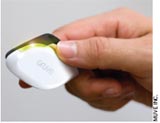
Sedentary Confinement
Do we really need reminding to move? Yes.
 By and large, we don’t get around like we used to. Technology at work and home has made it so we don’t need to. Who remembers actually getting up and crossing the room to switch the channel or walking across the office to deliver a message to a co-worker? Since the advent of universal remotes and e-mail, such “activities” have come to seem downright inefficient or, at the very least, inconvenient. We can do so much now without ever having to leave our seats that, typically, we don’t. But remaining happily on our cushions is not without its repercussions.
By and large, we don’t get around like we used to. Technology at work and home has made it so we don’t need to. Who remembers actually getting up and crossing the room to switch the channel or walking across the office to deliver a message to a co-worker? Since the advent of universal remotes and e-mail, such “activities” have come to seem downright inefficient or, at the very least, inconvenient. We can do so much now without ever having to leave our seats that, typically, we don’t. But remaining happily on our cushions is not without its repercussions.
It's no secret that, as a nation, we have been getting fatter for decades. Our obesity epidemic is well documented, and judging by the numbers from the World Health Organization and others, we are well on the path to becoming the real-life embodiments of the Pixar-lated humans envisioned in “WALL-E”; the sedentariness of the future society depicted in that film is so severe that our morbidly bloated descendants have, for all practical purposes, lost the use of their legs, perambulation having been replaced by multimedia-equipped hoverchairs that whisk them from place to place.
While the film presents an extreme extension, it follows recognizable trends already in place. Poor nutrition, lack of regular exercise, and genetic predisposition have long been recognized as drivers of obesity and all the assorted diseases and disabilities that go with it, but more recent research has proven that our drastically reduced non-exercise activity also is a contributing factor.Non-exercise activity includes all the “normal” or spontaneous physical movements we make in the course of a day outside of deliberate exercise. Taking the stairs, walking across the office, even gesticulating are examples. Scientists say our decrease in such activity is directly attributable to rampant automation and mechanization—in other words, technology.
It is ironic, then, that even more technology may be part of the solution, but that is just what Minneapolis-based Muve Inc. is banking on with the introduction of a three-part weight management system called the Gruve SolutionTM. Partly owned by the Mayo Clinic,Muve formed in 2007 and spent last year fine-tuning the system primarily in Twin Cities-area workplaces.Now deploying nationwide,Muve says its goal simply is to encourage otherwise inactive workers to get up and move.
Muvology™
The heart of the Gruve Solution is a personalized, palm-sized omnidirectional accelerometer-based device called the Gruve, which individuals wear on their waist. Developed by the Mayo Clinic’s Dr. James Levine, who also is Muve’s chief medical advisor, the device takes a data sample 10 times per second, measuring even the slightest activity and its duration, recording up to 10 days’worth on a memory chip inside. Each Gruve is programmed with the individual user’s resting metabolic rate and other biometrics, as well as Mayo-patented algorithms that allow it to instantly convert the captured data to caloric burn as movements happen.
Users can track their progress throughout the day by pressing a status bar on top of the device, which lights up in one of five colors, each signifying in real time where they are in their calorieburn goal. Any time the Gruve detects prolonged inactivity through a drop in metabolism—a period Levine calls “hibernation mode”—the device provides a gentle vibration to remind the wearer to get a move on.
Users can download all of the data in their device to Gruve OnlineTM, which is the second component of the system. This Web site is set up to provide education, support, and, if participants choose, social networking. Tools at the site convert the activity and caloric expenditure data into interactive charts, providing color-coded visual displays of what the Gruve recorded. According to Greg Soderberg, Muve’s vice president of business development, the site’s graphics make it easy for users to calculate their progress over the course of a month or down to the minute.
“Up until now, there has not been means of letting people know what they’re actually burning through their activity, but this program provides just that kind of feedback,” Soderberg says. “Once people get used to the charts, they can easily identify where the sedentary parts of their day are and, then, either through online guidance or through our onsite MuvologistsTM, we help them devise approaches or strategies to increase the activity or motion in their day.”
Muvologists—Muve’s name for the trained health care providers available to support Gruve users from the initial assessment and goal-setting phase all the way through to completion of the program—are the third part of the Gruve Solution. With diverse backgrounds ranging from physiology to psychology, each Muvologist is further trained and certified in protocols developed by both Muve and the Mayo Clinic.
According to Soderberg, all parts of the Gruve Solution work hand in hand and have been clinically proven to improve health, all of which sounds good. But have we really reached the point that we need reminding to move? The answer is yes. “It really is about behavior change, and our system is built to help guide people through that behavior change,” he says. “We’re a company that is really trying to make a difference and reverse these trends.”
This article originally appeared in the February 2009 issue of Occupational Health & Safety.